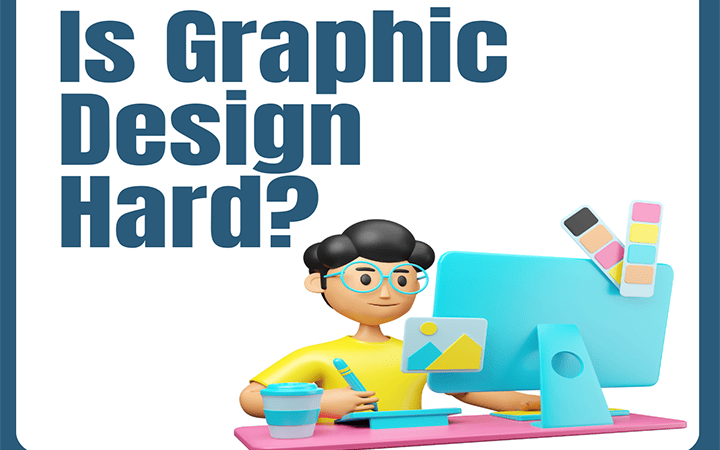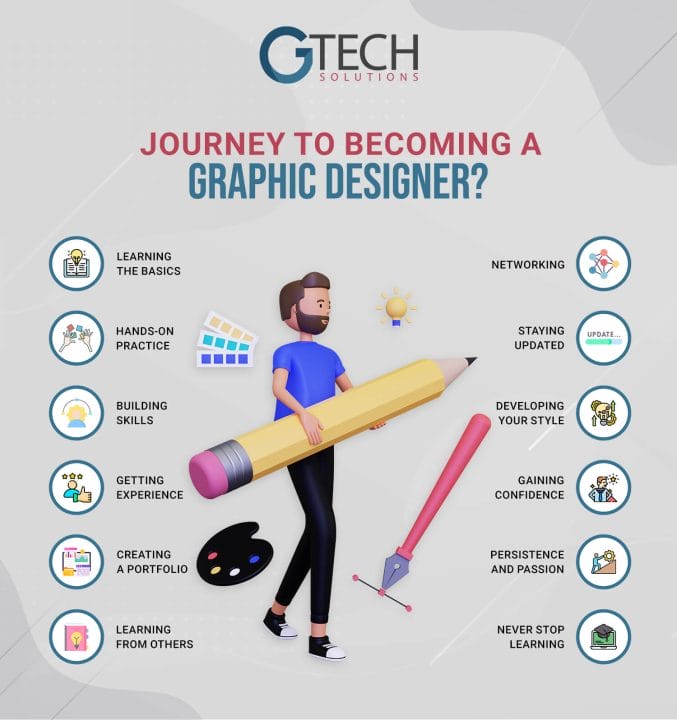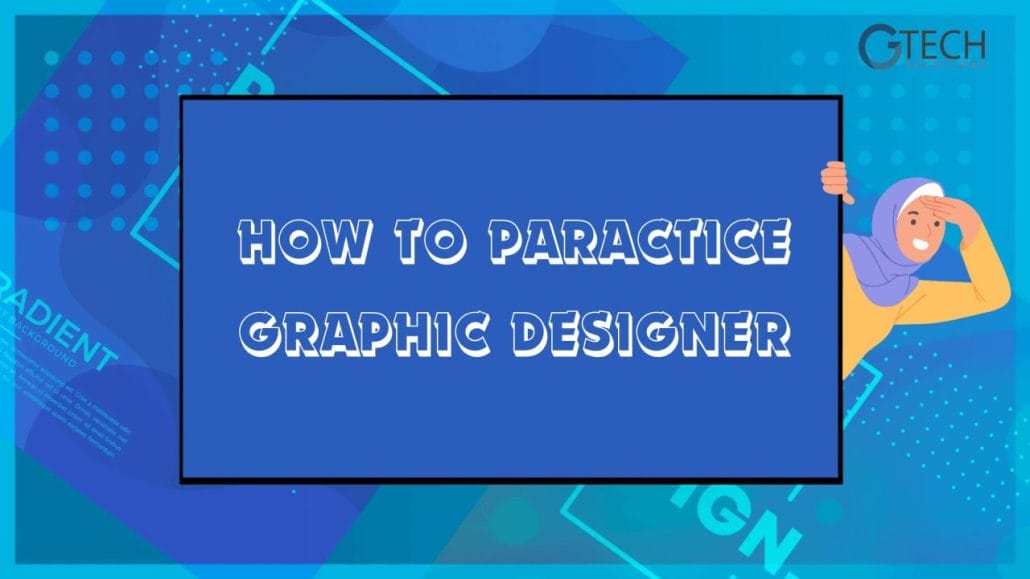
Is Graphic Design Hard? A comprehensive guide for beginners in 2024
“Graphic design is a creative and challenging field that requires artistic skills, design knowledge and technical skills. It is not hard to learn graphic design, but it does take time, effort, and passion. To become a successful graphic designer, you must master essential tools, such as Photoshop, Illustrator, and InDesign.”
You also need to understand design principles and concepts, such as colour, typography, layout, and texture. You need to practise and improve your design skills and keep up with the latest design trends and technologies. Most importantly, you must have a strong work ethic and a passion for creating beautiful and functional designs.
Reasons Why Graphic Design is Not Hard
Graphic design is a skill that you can learn and master with ease. Here are some of the reasons why graphic design is not hard.
You need a positive attitude
To become a graphic designer, you need to love arts and design and have a passion for creating visuals. You also need to be patient and persistent in your learning process and not give up easily.
A positive attitude will help you enjoy your journey as a graphic designer. You will be able to learn from other designers and develop your unique style.
You need a computer
To become a graphic designer, you need a computer that can run the design software you need. You don’t need a fancy or expensive computer, just a decent computer.
The computer is your main tool as a graphic designer. You can use it to create, edit and save your designs. You can also use it to access online resources that can help you learn and improve your skills.
You need online resources
To become a graphic designer, you don’t need to go to school or get a degree. You can learn graphic design by yourself using online resources. You can find online courses, tutorials, books, videos, and more that can teach you everything you need to know about graphic design.
You don’t need to draw
To become a graphic designer, you don’t need to draw anything by hand. You can create stunning designs without drawing using design software. You can use design software to create and manipulate shapes, colours, fonts, images, and more with ease.
Design software is very powerful and versatile. You can use it to create logos, icons, posters, flyers, brochures, websites, apps, and more. You can also use it to edit and enhance your photos, illustrations, and graphics.
You need confidence
To become a graphic designer, you need confidence. You need to believe in yourself and your abilities. You need to be proud of your work and your achievements. You need to trust your decisions and your choices.
Confidence will help you grow and improve as a graphic designer. You will be able to take risks and try new things. You will be able to handle pressure and deadlines and deliver quality work. You will also be able to impress your clients and employers and gain more opportunities and recognition.
How Long Does It Take To Become a Graphic Designer?
Becoming a graphic designer takes a different amount of time, depending on how you choose to learn. If you go to university for graphic design, it usually takes four years. After that, you may need a few extra months to gain experience. For those taking a graphic design course or UX design bootcamp, the learning time is short, lasting from a few weeks to months.
But you will need a year to a few extra months to build a good portfolio. If you decide to teach yourself, you can learn at your own pace using online resources like tutorials and videos. Thus, it may take you about a year or more to become an expert graphic designer.
“Remember, the amount of time it takes depends on your commitment and how you decide to learn, so have the flexibility to choose the path that works best for you”.
Finding your graphic design speciality is an important step in your career path. Your specialty is a specific area of graphic design that you love and excel at, such as 3D design, poster design, illustration design, web design, or animation design. Each specialty has its subcategories, careers, and prerequisites.
To find your graphic design speciality:
- 🌐 Explore different fields through online courses, books, videos, portfolios and projects.
- 🤔 Consider your strengths, skills, goals, and priorities to identify your interests.
- 🗣️ Seek guidance from professionals in various specialities through online platforms, forums or events.
- 🎨 Experiment with different projects and challenges to test your creativity and skills
- 🔄 Review feedback and results to determine the best-fit speciality based on demand, opportunities and trends for your career goals and aspirations.
What makes a good graphic designer?
A good graphic designer has a combination of creativity, technical skills, attention to detail, and a deep understanding of design principles. Effective communication, adaptability, and a strong portfolio showcasing diverse and impactful work are also important attributes.
Principles of Graphic Design
Graphic design relies on fundamental principles that guide designers in creating visually compelling communication. These principles serve as building blocks for developing designs that resonate with audiences.
Some important principles of graphic design are:
Balance
Achieving visual balance by dividing elements to create a sense of stability, whether symmetrical or asymmetrical.
Contrast
Emphasising differences between elements, such as colour, size or shape, to create visual interest and highlight important information.
Hierarchy
Establishing a clear order of importance within a design, guiding the viewer’s eye through an organised layout and emphasising important elements.
Unity
Ensuring harmony and harmony in design by connecting elements through similar styles, colours and themes.
Alignment
Organising elements along a common axis to create a sense of order and harmony, enhancing the design’s readability and visual appeal.
Repetition
Consistent use of specific design elements, such as patterns or fonts, to create a unified and cohesive visual identity throughout the project.
Proximity
Grouping related elements to establish relationships and increase overall readability makes it easier for the audience to interpret the information.
White Space (Negative Space)
Allowing intentional spaces around and between elements increases clarity, readability and visual impact.
Colour Theory
Understanding the psychological and emotional effects of colours and using them strategically to evoke specific responses from the audience.
Typography
Selecting and arranging fonts in a way that complements the overall design, ensures readability and conveys the desired tone.
By following these principles, graphic designers can create visually appealing and effective designs that convey messages clearly and resonate with their intended audience.
Learn Latest Graphic Design Trends and Technology
It is important to keep your skills up to date in graphic design. Design trends change quickly, and to stay on top, you have to know what’s hot. Learning the latest trends ensures that your designs are fresh and popular.
Tech Tools for Creativity
It’s not just about what looks good. Knowing the latest technology is also very important. Understanding the latest tools used by professionals can take your design to the next level. Adopting these tech advancements enhances your creative process and keeps you ahead in the world of graphic design.
Impact of AI in Design
Technology, especially with the rise of AI, has changed the way designers work. AI helps create graphic content efficiently, saving time and costs. It’s not just about retention; It’s about using these tools to boost creativity, reduce mistakes and take your graphic design to a whole new level.
How to Practise Graphic Design
Becoming a skilled graphic designer requires dedication, creativity, and a willingness to learn and practice constantly. Whether you’re a seasoned designer or just starting, there are always ways to improve your skills and expand your portfolio.
Here are some effective strategies for practising graphic design:
- Start with the basics
- Take on personal projects
- Participate in design challenges and competitions
- Seek feedback and critique
- Practise regularly
- Stay up-to-date with design trends
- Experiment with different styles
- Contribute to open-source design projects
- Seek inspiration from other designers
- Never stop learning
As we conclude our exploration of graphic design, a special mention goes to G-Tech Sol, your go-to centre for top-notch graphic design services in Sydney. Whether you’re starting your creative journey or honing your skills, G-Tech Sol stands out as a landmark in the world of graphic design in Sydney. Here’s to showcasing your creativity with the best in the business!






